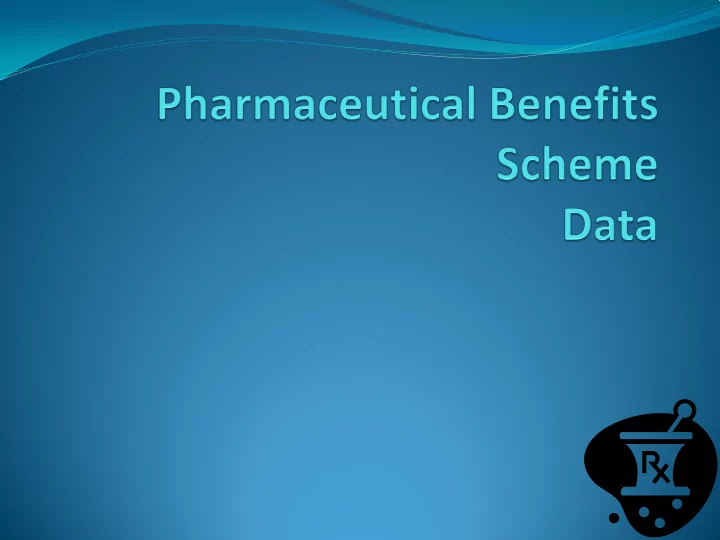

PBS Data Flow Prescriptions are written by approved prescribers Drugs are supplied to patients by approved suppliers S90 pharmacies and Friendly societies (95%) S94 hospital pharmacies S92 dispensing doctors Pharmacies have online claiming – real time interaction with the DHS (98%) Collect co-pay from patients Submit claim to DHS for balance Pharmacies are required to provide specified data to DHS as part of claim also required to submit under co-pay data (from April 2012) note private scripts are not captured
PBS Data Flow DHS process claims and make payments to pharmacy After validation DHS provide prescription data to Health can be a lag of up to 3 months Around 300 million prescriptions annually at a cost to Government of around $9 billion. PBS database maintained by Health contains comprehensive information about each script dispensed: Pharmacy Patient Prescriber Drug
PBS Data – What the Department of Health holds Information about the patient: patient date of birth (to determine patient age at time of dispensing) patient gender patient postcode patient state
PBS Data – What the Department of Health holds Information about the prescription: drug manufacturer (to determine brand) quantity dispensed date of prescribing date of supply whether general or concessional, ‘safety-net’ or ‘non safety-net’ form/strength government benefit patient co-payment
PBS Data – What the Department of Health holds Other available information: dispensing setting (ie. community pharmacy or hospital pharmacy) pharmacy postcode pharmacy state major specialty of prescriber Information collected by the Department of Human Services on the approval of authority prescriptions
Monitoring Utilisation with PBS data – Example simple analyses Report 1: Number of prescriptions and patients by brand by month Brand 1 Brand 2 Month Prescriptions Patients Prescriptions Patients December 2015 January 2016 February 2016 … Total to date Report 2: Number of patients switching brands, all indications, by State/Territory. December 2015 to xxxxxxx Number of switches State 1 2 3 4 5 … NSW VIC … AUST Report 3: Number of patients switching brands, by indication. December 2015 to xxxxxxx Number of switches Indication 1 2 3 4 5 … Indication 1 Indication 2 … Indication Unknown All Indications
Monitoring Utilisation with PBS data – further analysis • Established process for monitoring use of medicines listed on the PBS • Analyses are undertaken for the Drug Utilisation Subcommittee (DUSC) and the PBAC • usually 24 months after listing on the PBS; or • at other times requested by the DUSC or PBAC • The impact of listing biosimilars could be monitored through several approaches used in reporting for the PBAC and its DUSC. • Utilisation reviews are published on the PBS website http://www.pbs.gov.au/info/industry/listing/participants/public- release-docs/dusc-utilisation-public-release-docs
Prescription Volume • Assessing market share and growth − For example changes in the a drug’s market for a particular condition over time* • Data can also be presented by brand to assess market share of reference medicine and biosimilars
Indication • Indication is known when there is a separate PBS item or authority code − For example the item codes for a drug that can be used for different conditions will have different codes for each of the conditions − For some drugs there is also a different item code for initial and continuing treatment − For others, there is also a different item code for public and private hospital supply • Can monitor whether utilisation patterns for reference and biosimilar differ across indications
Patient numbers • Quantifying the number of patients: incident (new) and prevalent (all) − For example new and all patients treated with a group of drugs for a specific condition over time 6000 5000 Number of patients 4000 3000 Prevalent patients New Patients 2000 1000 0 2006 2007 2008 2009 2010 2011 2012 2013 2014 Calendar year
Patient numbers by drug • Distribution of patients by drug prescribed − For example new patients treated with a drug for a particular condition • Data can also be presented by whether the reference or biosimilar was first supplied product.
Transitions between drugs • Patient level analyses can be undertaken, using various methods, to examine switching, adding or ceasing medicines. • Transitions (single or multiple) between reference and biosimilars could also be incorporated into these types of analyses.
Treatment duration and discontinuation rates • Time on treatment & discontinuation rate analyses can be undertaken • Most common approach is Kaplan-Meier (K-M) analysis. • A simplified approach assesses continuation rates based on repeat approvals • Assumptions are needed to identify likely discontinuations from treatment breaks. • Different cohorts such as reference only, biosimilar only, single and multiple switchers could be compared .
Other possible analyses • Prescriber type to assess whether patterns of use vary between specialities, or between specialists and GPs • Co-prescription analyses
Linking PBS and MBS data Linking strictly controlled by law Privacy Guidelines enacted under Section 135AA of the Nation Health Act 1953 Enables analysis of GP/specialist usage for patients who switch and don’t switch Is there a difference in MBS item levels of usage? Do the MBS items accessed differ between groups?
Recommend
More recommend